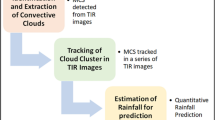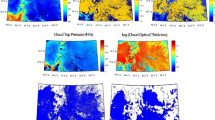Abstract
The present study aimed to investigate the potential of possible rain area delineation schemes based on the enhanced infrared spectral resolution of the Meteosat Second Generation–Spinning Enhanced Visible and Infrared Imager. The proposed schemes use the brightness temperature (BT) Τ 10.8 along with the brightness temperature differences (BTDs) Τ 10.8 − Τ 12.1, Τ 8.7 − Τ 10.8, and Τ 6.2 − Τ 10.8 as spectral cloud parameters. Two different methods were used to develop the rain area delineation models. The first is a common threshold technique in the multispectral space of the spectral cloud parameters, and the second is an algorithm based on the probability of rain (PoR) for each pixel of the satellite data. Both schemes were trained using as rain information gauge data from 41 stations in Greece for 107 rainy days, covering a period of 1 year. As a result, one single-infrared model (TB10), three two-dimensional (BTD10–12, BTD8–10, and BTD6–10), and two multidimensional models (BTDall and PoR) were constructed and verified against an independent sample of rain gauge data for four daily precipitation events. It was found that the introduction of BTDs as additional information to a model works in improving the discrimination of rain from no-rain events compared with the single-infrared model BT10. During the training phase, BTDall exhibited the best performance among the threshold techniques, while the PoR model outperformed all the threshold techniques, producing scores slightly better than those of BTDall model. When verifying against the independent dataset, all models exhibited the same performance with that of the dependent dataset according to the ETS score but less skill according to the HK score. The proposed techniques, however, still perform better than the single-infrared technique but with different ranking; BTall performs best followed by PoR and BTD10–12. Finally, two case studies are presented to gain a visual impression of the performance of the new developed rain area delineation schemes, showing the effectiveness of BTDall in delineating the thicker part of cirrus clouds and of PoR in detecting rain from the low-level thick clouds.









Similar content being viewed by others
References
Ackerman SA, Moeller CC, Strabala KI, Gerber HE, Gumley LE, Menzel WP, Tsay SC (1998a) Retrieval of effective microphysical properties of clouds: a wave cloud case study. Geophys Res Lett 25:1121–1124
Ackerman SA, Strabala KI, Menzel WP, Frey RA, Moeller CC, Gumley LE (1998b) Discriminating clear sky from clouds with MODIS. J Geophys Res-Atmos 103:32141–32157
Adler RF, Negri AJ (1988) A satellite infrared technique to estimate tropical convective and stratiform rainfall. J Appl Meteor 27:30–51
Arkin PA (1979) The relationship between fractional coverage of high clouds and rainfall accumulation during GATE over B-scale array. Mon Wea Rev 107:1382–1387
Arkin PA, Meisner BN (1987) The relationship between large-scale convective rainfall and cold cloud over the Western Hemisphere during 1982–1984. Mon Wea Rev 115:51–74
Baum BA, Platnick S (2006) Introduction to MODIS cloud products. In: Qu JJ, Gao W, Kafatos M, Murphy RE, Salomonson VV (eds) Earth science satellite remote sensing: Science and instruments. Springer, Berlin, p 78
Baum BA, Arduini RF, Wielicki BA, Minnis P, Tsay SC (1994) Multilevel cloud retrieval using multispectral HIRS and AVHRR data: nighttime oceanic analysis. J Geophys Res-Atmos 99:5499–5514
Baum BA, Soulen PF, Strabala KI, King MD, Ackerman SA, Menzel WP, Yang P (2000) Remote sensing of cloud properties using MODIS airborne simulator imagery during SUCCESS, 2, Cloud thermodynamic phase. J Geophys Res 105(11):781–11, 792
Bellon A, Lovejoy S, Austin GL (1980) Combining satellite and radar data for the short-range forecasting of precipitation. Mon Wea Rev 108:1554–1556
Brown BG, Young GS (2000) Verification of icing and turbulence forecasts: why some verification statistics can’t be computed using PIREPs. Preprints, 9th Conference on Aviation, Range, and Aerospace Meteorology, Orlando, FL, 11–15 September, American Meteorological Society (Boston), 393–398.
Cheng M, Brown R, Collier CG (1993) Delineation of precipitation areas by correlation of Meteosat visible and infrared data in the region of the United Kingdom. J Appl Meteor 32:884–898
Donaldson RJ, Dyer RM, Kraus MJ (1975) An objective evaluator of techniques for predicting severe weather events. In: Preprints, 9th Conf. on Severe Local Storms, Norman, OK, Am. Meteorol. Soc., pp. 321–326
Doneauld AA, Ionesku-Niscov S, Priegnitz DL, Smith PL (1984) The area time integral as an indicator for convective rain volume. J Climate Appl Meteor 23:555–561
Ebert EE, Janowiak JE, Kidd C (2007) Comparison of near-real-time precipitation estimates from satellite observations and numerical models. Bull Amer Meteorol Soc 88:47–64
Fritz S, Laszlo I (1993) Detection of water vapor in the stratosphere over very high clouds in the tropics. J Geophys Res 98(D12):22959–22967
Früh B, Bendix J, Nauss T, Paulat M, Pfeiffer A, Schipper JW, Thies B, Wernli H (2007) Verification of precipitation from regional climate simulations and remote-sensing observations with respect to ground-based observations in the upper Danube catchment. Meteorol Z 16:275–293
Gerapetritis H, Pelissier JM (2004) The critical success index and warning strategy. 17th Conference on Probablity and Statistics in the Atmospheric Sciences. 10–14 January 2004, Seattle, Washington
Griffith CG, Woodley WL, Browner S, Teijeiro J, Maier M, Martin DW, Stout J, Sikdar DN (1976) Rainfall estimation from geosynchronous satellite imagery during daylight hours. NOAA Technical Report ERC 356-WMPO 7, Washington, D.C., USA
Griffith CG, Grube PG, Martin DW, Stout J, Sikdar DN (1978) Rainfall estimation from geosynchronous satellite imagery, visible and infrared studies. Mon Wea Rev 106:1153–1171
Griffith CG, Augustine JA, Woodley WL (1981) Satellite rain estimation in the U.S. High Plains. J Appl Meteor 20:53–66
Haklander AJ, Van Delden A (2003) Thunderstorm predictors and their forecast skill for the Netherlands. Atmos Res 67–68:273–279
Hanssen AW, Kuipers WJA (1965) On the relationship between the frequency of rain and various meteorological parameters. Koninklijk Nederlands Meteorologisch Institut Meded Verhand 81:2–15
Hong Y, Hsu K, Sorooshian S, Gao X (2004) Precipitation estimation from remotely sensed imagery using an artificial neural network cloud classification system. J Appl Meteor 43:1834–1852
Hsu K, Gao X, Sorooshian S, Gupta HV (1997) Precipitation estimation from remotely sensed imagery using an artificial neural network. J Appl Meteor 36:1176–1190
Huang HL, Yang P, Wei HL, Baum BA, Hu YX, Antonelli P, Ackerman SA (2004) Inference of ice cloud properties from high spectral resolution infrared observations. IEEE T Geosci Remote 42:842–853
Inoue T (1985) On the temperature and effective emissivity determination of semi-transparent cirrus clouds by bi-spectral measurements in the 10-mm window region. J Meteor Soc Japan 63:88–99
Inoue T (1987a) A cloud type classification with NOAA-7 split-window measurements. J Geophys Res 92:3991–4000
Inoue T (1987b) An instantaneous delineation of convective rainfall areas using split window data of NOAA-7 AVHRR. J Meteor Soc Japan 65:469–481
Inoue T (1989) Features of clouds over the tropical Pacific during Northern Hemispheric winter derived from split window measurements. J Meteor Soc Japan 67:621–637
Inoue T (1997) Day-to-night cloudiness change of cloud types inferred from split window measurements aboard NOAA polar-orbiting satellites. J Meteor Soc Japan 75:59–66
Inoue T, Ackerman SA (2002) Radiative effects of various cloud types as classified y the split window technique over the eastern sub-tropical pacific derived from collocated ERBE and AVHRR data. J Meteor Soc Japan 80:1383–1394
Inoue T, Aonashi K (2000) A comparison of cloud and rainfall information from instantaneous visible and infrared scanner and precipitation radar observations over a frontal zone in East Asia during June 1998. J Appl Meteor 39:2292–2301
Inoue T, Wu X, Bessho K (2001) Life cycle of convective activity in terms of cloud type observed by split window. 11th Conference on Satellite Meteorology and Oceanography, Madison, WI, USA
Kurino T (1997) A rainfall estimation with the GMS-5 infrared split-window and water vapour measurements. Meteorol Center Tech Note, Japan Meteorol Agency 33:91–101
Lattanzio A, Watts PD, Govaerts Y (2006) Activity Report on physical interpretation on warmwater vapour pixels. Technical Memorandum No.14, Programme Development Department, February 2006
Lensky IM, Rosenfeld D (2003) A night-rain delineation algorithm for infrared satellite data based on microphysical considerations. J Appl Meteor 42:1212–1226
Lopez RE, Atlas D, Rosenfeld D, Thomas JL, Blanchard DO, Holle RL (1989) Estimation of rainfall using the radar echo area time integral. J Appl Meteor 28:1162–1175
Lutz H-J, Inoue T, Schmetz J (2003) NOTES AND CORRESPONDENCE Comparison of a split-window and a multi-spectral cloud classification for MODIS observations. J Meteor Society of Japan 81(3):623–631
Mason IB (1982) A model for the assessment of weather forecasts. Aust Meteor Mag 30:291–303
Mason I (1989) Dependence of the critical success index on sample climate and threshold probability. Aust Meteorol Mag 37:75–81
McBride JL, Ebert EE (2000) Verification of quantitative precipitation forecasts from operational numerical weather prediction models over Australia. Wea Forecasting 15:103–121
Nauss T, Kokhanovsky AA (2007) Assignment of rainfall confidence values using multispectral satellite data at mid-latitudes: first results. Adv Geosc 10:99–102
Nauss T, Kokkanovsky A (2006) Discriminating raining from non-raining clouds at mid-latitudes using multispectral satellite data. J Atmos Chem Phys 6:5031–5036
Negri AJ, Adler RF, Wetzel PJ (1984) Satellite rain estimation: an analysis of the Griffith–Woodley technique. J Climate Appl Meteor 23:102–116
Pavolonis MJ, Heidinger AK, Uttal T (2005) Daytime global cloud typing from AVHRR and VIIRS: algorithm description, validation, and comparisons. J Appl Meteor 44:804–826
Rubel F, Rudolf B (2001) Global daily precipitation estimates proved over the European Alps. Meteorol Z 10:407–418
Schaefer JT (1990) The critical success index as an indicator of warning skill. Wea Forecasting 5:570–575
Schmetz J, Tjemkes SA, Gube M, van de Berg L (1997) Monitoring deep convection and convective overshooting with METEOSAT. Adv Space Res 19:433–441
Schmetz J, Pili P, Tjemkes S, Just D, Kerkmann J, Rota S, Ratier A (2002) An introduction to Meteosat Second Generation (MSG). B Am Meteorol Soc 83:977–992
Strabala KI, Ackerman SA, Menzel WP (1994) Cloud properties inferred from 8 to 12-μm data. J Appl Meteorol 33:212–229
Swets JA (1973) The relative operating characteristic in psychology. Science 182:900–1000
Thies B, Nauss Τ, Bendix J (2008a) Discriminating raining from non-raining cloud areas at mid-latitudes using meteosat second generation SEVIRI night-time data. Meteorol Appl 15:219–230
Thies B, Nauss T, Bendix J (2008b) A new technique for detecting precipitation at mid-latitudes during daytime using Meteosat Second Generation SEVIRI. 2008 EUMETSAT Meteorological Satellite Conference, Darmstadt, Germany
Vicente GA, Davenport JC, Scofield RA (2002) The role of orographic and parallax corrections on real time high resolution satellite rainfall rate distribution. Int J Rem Sens 23(2):221–230
Wu MC (1984) Radiation properties and emissivity parameterization of high level thin clouds. J Clim Appl Meteorol 23:1138–1147
Acknowledgements
The authors wish to thank the Hellenic National Meteorological Service and the National Observatory of Athens for providing the precipitation data from their network of ground stations.
Author information
Authors and Affiliations
Corresponding author
Rights and permissions
About this article
Cite this article
Feidas, H., Giannakos, A. Identifying precipitating clouds in Greece using multispectral infrared Meteosat Second Generation satellite data. Theor Appl Climatol 104, 25–42 (2011). https://doi.org/10.1007/s00704-010-0316-5
Received:
Accepted:
Published:
Issue Date:
DOI: https://doi.org/10.1007/s00704-010-0316-5




